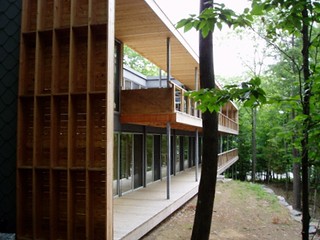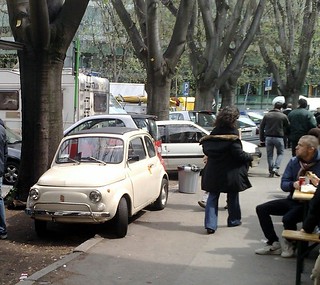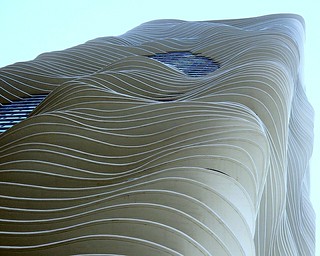Lloyd Alter brings it on the car culture, "gizmo" technology, architecture, green lifestyles, & cities

Posted February 11, 2013 at 2:30PM

Toronto-based Lloyd Alter is one of the most prolific environmental thinkers and writers on the web. What I like best about his work is that he avoids the traps presented by ideology and thinks for himself, on subjects ranging from "gizmo" green technology to how cars are dominating our cities. In addition to his day job, Lloyd is a licensed architect and adjunct professor at Ryerson University.
Today, Lloyd takes the reins as the new managing editor of TreeHugger, one of the web's best-known environmental sites. I thought that made it a good time to get his views on cities, buildings, and the environment. We conducted this interview via email over the past couple of weeks.
Lloyd, let’s start with the obvious: you’re now the managing editor of TreeHugger, a well-established environmental website. How did you get to where you are?
A dozen years ago, after a decade of being a real estate developer in Toronto, Canada, I became convinced that the way we build was totally screwed up and that prefabrication was the future. I went to work for Canada’s biggest prefab manufacturer to create a green modern prefab and was certain that the world would beat a path to my door. While waiting for that rush that never came, I built a website discussing prefab that I updated every day with news and stories; a proto-blog before the word existed. The day blog software came out I was on it, and discovered TreeHugger about the day it went live. I sent them tips, then they asked me to write for them, and it just grew from there. It was a lot more fun than trying to sell prefabs.
How would you characterize TreeHugger’s place on the web? Is there a core philosophy or mission? Is there anything in particular you’d like to add or emphasize going forward?
TreeHugger was founded as a “green lifestyle filter” to make sustainability cool. When I look back at the bamboo shirts and some of the endless posts on  vampire power or clotheslines I cringe now. But we lost the green lifestyle stuff and tried to cover everything from climate change to peak oil and, I think, got in over our heads. There are specialty sites like Climate Progress that are the go-to sites for serious coverage of such issues.
vampire power or clotheslines I cringe now. But we lost the green lifestyle stuff and tried to cover everything from climate change to peak oil and, I think, got in over our heads. There are specialty sites like Climate Progress that are the go-to sites for serious coverage of such issues.
The fact of the matter is, lifestyle really matters. As I learned from you, where you live is much more important than what you live in, having enough is better than having more, we have to eat down the food chain and get around down the transportation chain.
I hope to take TreeHugger back to its lifestyle roots, with bikes instead of bamboo.
You’ve covered a range of fascinating subjects in your writing. Tell us about some favorites.
Six years ago I joined the Architectural Conservancy of Ontario and 4 years ago became its president, visiting towns and cities around Ontario. While the organization was created to advocate for historic buildings, I became far more interested in historic patterns of development, how buildings, cities and towns designed before the age of oil can be templates for life after the oil is gone. When you, Steve Mouzon and I started writing about this kind of stuff it was pretty out there; now it is almost accepted wisdom. I like to think we all had a bit to do with that.
Were there any that proved particularly controversial?
My anti green-gizmo stance, and right now, my anti-plastics rants. Particularly in the USA, green = energy efficiency so everyone is building tighter, better insulated buildings that are full of poison, from flame retardants to phthalates to formaldehyde to radon.  But it’s controversial to come out against an insulation that gets R-7 per inch.
But it’s controversial to come out against an insulation that gets R-7 per inch.
I just don’t think you should sacrifice peoples’ health in the name of energy efficiency.
The other thing that always gets me into trouble is my belief that most Americans know the price of everything and the value of nothing. Every green building should cost $60 bucks a foot and every piece of design should be priced like a Billy Bookcase from IKEA. The fact that something might be made in small quantities by craftspeople out of healthy materials seems irrelevant.
You seem to like modernism, historic buildings, and natural areas. On the surface, those are very different things. Is there a common thread, or are we seeing different parts of your ethic or personality in the three?
No, you are seeing utter confusion. I used to be a committed modernist; then, while studying historic buildings, I learned how well they work. How windows could be tuned for maximum ventilation; how shutters provided security and privacy while maintaining ventilation; how really bad modern buildings are when it comes to being green and healthy. Those clean lines, lack of roof overhangs and walls of glass didn’t look so beautiful any more.
What makes a great building? A great city?
I am not certain that there is a great city in the world that wasn’t great a hundred years ago. I haven’t been to Singapore, but that is about the only example I can think of that might break the rule. But almost all of the cities we admire today were designed before the automobile became the motivator for every planning and urban design decision.
The trouble is, the automobile is ruining even the cities that we admire. I was in Milan last year and was appalled at how every sidewalk, almost every public square was filled with parked cars. They were everywhere.  It was the same in Rome, where pedestrian crosswalks are considered parking spaces. The drivers are terrific; our guide told us the way to cross the street is to “close your eyes and just step off the curb; don’t worry, it’s your road too and they will stop for you” and they do. But they park everywhere.
It was the same in Rome, where pedestrian crosswalks are considered parking spaces. The drivers are terrific; our guide told us the way to cross the street is to “close your eyes and just step off the curb; don’t worry, it’s your road too and they will stop for you” and they do. But they park everywhere.
Florence and Toronto tried to fight the car culture; Florence has amazing computerized bollards that pop up at 9:00 in the morning to close off its historic downtown to cars and trucks. Toronto started putting in bike lanes and a surface light rail system. In both cases, the mayors got thrown out and the policies got reversed. The same thing might happen post-Bloomberg in New York.
As for what makes a great building, see the previous question; I just don’t know anymore. I used to be able to look at a building and say I liked it; now I find it meaningless without knowing the context. Although I must admit the Barnes in Philadelphia took my breath away.
What’s the most important thing to keep in mind as we consider the future of our built environment?
The past of our built environment.
Name a favorite piece (or two) of art, music or culture.
 I recently returned from Rome, where I saw the work of Bernini in the flesh (even though it is marble, it looks like flesh) for the first time. I was completely entranced, particularly by Apollo and Daphne. You simply cannot believe that anyone could do that in marble. Until I saw that, I thought that you could understand and appreciate art through books and through technology. I was wrong; there is no substitute for reality.
I recently returned from Rome, where I saw the work of Bernini in the flesh (even though it is marble, it looks like flesh) for the first time. I was completely entranced, particularly by Apollo and Daphne. You simply cannot believe that anyone could do that in marble. Until I saw that, I thought that you could understand and appreciate art through books and through technology. I was wrong; there is no substitute for reality.
One thing that you and I seem to agree on is that just because urban density is essential, maximizing density doesn’t necessarily maximize benefits. Could you say more about your opinion on that?
I wish you hadn’t asked this, I could go all day. This is a real problem that is going to be vexing us for some time. Every economist, including some that I respect, is jumping into the pool, making the case that controls on density are hurting cities and economies. Environmental writers and thinkers are piling on, all of them claiming that we need to fill our cities with 40 story buildings. A renowned architect can design a building that is essentially a pile of radiator fins but call it green because it packs 750 apartments on a third of an acre, saying that the most important thing we can do for the environment is live in compact cities with mass transit.
I am convinced that they are wrong, that there is a “goldilocks density” that is high enough to support a vibrant, walkable community,  but not so high that you can’t walk up to your apartment when the power goes out, that needs expensive infrastructure like subways and huge underground parking garages. Dense enough to build a sense of community, but not so dense as to have everyone slip into anonymity.
but not so high that you can’t walk up to your apartment when the power goes out, that needs expensive infrastructure like subways and huge underground parking garages. Dense enough to build a sense of community, but not so dense as to have everyone slip into anonymity.
For economists, they don’t seem to understand basic economics: that the price of housing has nothing to do with the supply of housing, it has to do with the supply of money. They could fill New York with 40 story towers but if the banks won’t give mortgages, nobody is going to be buying apartments. And if you flood the market with housing to make the price go down, nobody is going to lend anyone a dime.
One economist uses Houston as an example, saying it proves that lack of zoning controls leads to affordable housing and economic growth. Houston as the urban ideal?
This needs a lot more careful study and a proper retort. I was going to try and write a book about it when I thought I was going to get laid off in the fall; instead I got promoted, so the book will have to wait.
Where else would you like to be right now?
Back at the Galleria Borghese in Rome, looking at Apollo and Daphne.
This is the first of an occasional series of interviews with leaders who are shaping the field of sustainable communities. Lloyd’s provocative “Design Stories that Will Resonate in 2013” may be found on TreeHugger, where you can also access a long and fascinating list of his excellent articles for the site.
Related posts:
- Mitigating the environmental paradox of smart growth: softening urban density (November 26, 2012)
- Cities, sustainable placemaking, & the careful use of words (September 5, 2012)
- The greenest (historic) building is the one that's in the right context (June 16, 2011)
- Re-calibrating green building certification in two cartoons (June 23, 2011)
- The messy issue of design in smart growth (January 6, 2011)
- Denver's Aria raises the bar for smart, sustainable neighborhoods - with prefab construction! (August 25, 2009)
Move your cursor over the images for credit information.